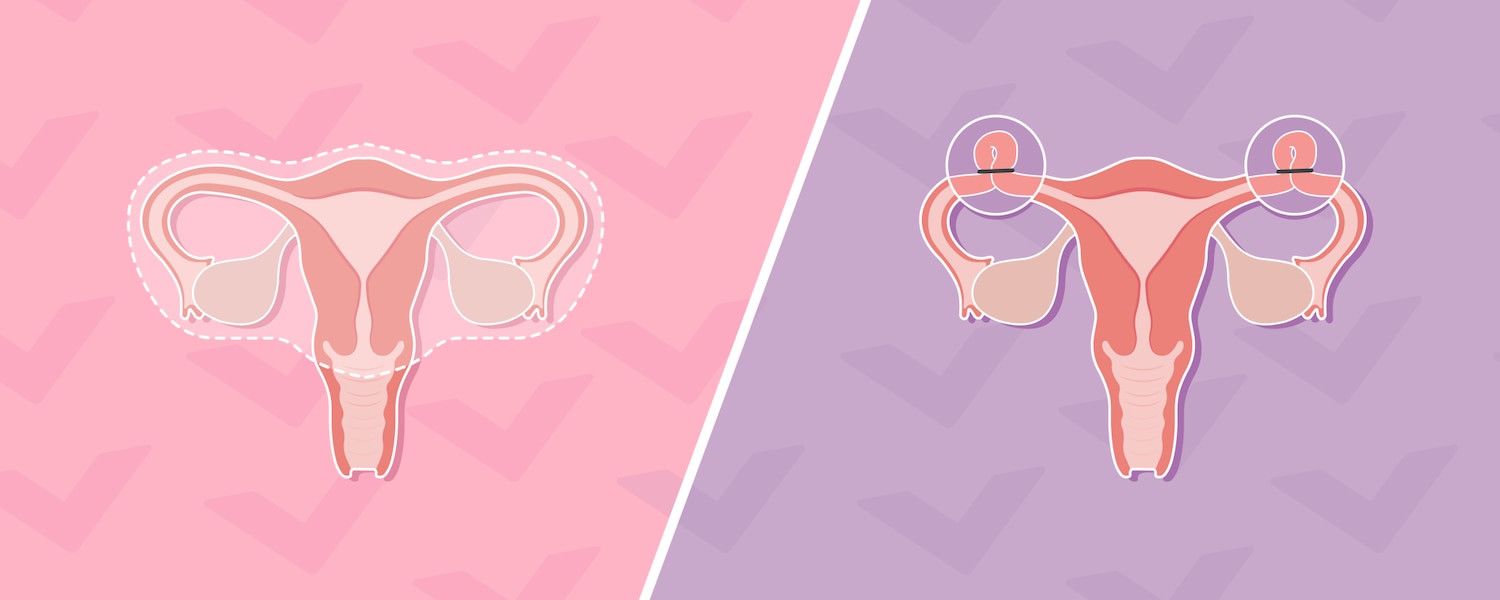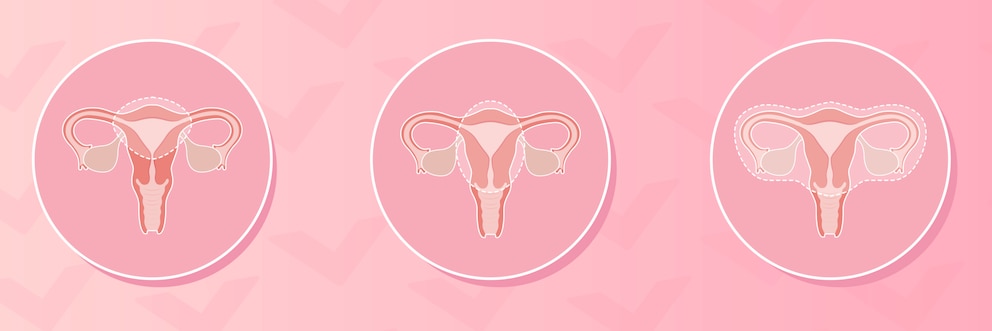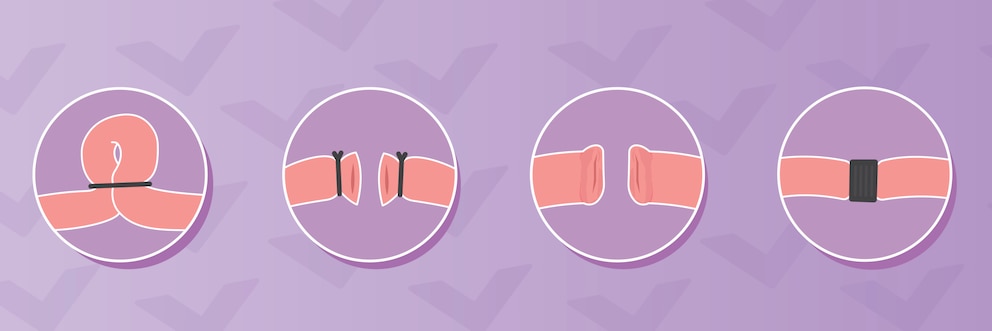Tubal ligation vs hysterectomy: what’s the difference?

There are a few different reasons someone might consider surgery related to reproductive health. It can sometimes be tricky to understand the differences — and figure out what’s right for you
Whether you’re looking into permanent or long-term options for birth control or learning about treatments for specific health concerns, getting a simple rundown of each procedure can make things a lot clearer. Let's take a look at the similarities between a hysterectomy and tubal ligation, and when each might come into play.
What is a hysterectomy?

What is tubal ligation?
Tubal ligation (often known as "getting your tubes tied") in simple terms, is a surgical procedure that closes off the fallopian tubes (sometimes called uterine tubes) so that eggs and sperm can’t meet, which means pregnancy can't happen. Often, doctors use a laparoscope — a tiny camera with a light — inserted through a small cut near the belly button to see the fallopian tubes. Then, they close off the tubes using clips, rings, or by sealing them with an electric current.

How are hysterectomies and tubal ligation similar?
Hysterectomies and tubal ligation have a few key similarities that often make people compare them when considering what's best for their reproductive health and their unique life circumstances.
They can both be used as permanent forms of birth control
If you've decided that having children isn't what fulfils you and don't want the worry of an unexpected, unwanted pregnancy, both procedures are effective, safe and reliable permanent birth control options.They can both lower your risk of ovarian cancer
Both hysterectomies and tubal ligation can actually help lower the risk of ovarian cancer, as they stop cancer cells from being transferred to your ovaries from other parts of your reproductive system. This can be a comforting benefit for people who might be considering these procedures for other reasons like birth control or if they have a family history of reproductive conditions. A study from the Journal of Ovarian Research found that both procedures can lower the risk of developing this type of cancer by as much as 30%.[1] This can be especially reassuring for people who might have a family history of these kinds of conditions.They’re both major operations
Both hysterectomies and tubal ligation are big decisions because they’re major surgeries, so it’s a good idea to consider all the factors before choosing what’s right for you. These procedures do require some downtime for recovery before you can get back to your usual routine. After a hysterectomy, you’ll need several weeks (around 6-8 weeks) [2] to rest and regain strength. Even tubal ligation, which is a less invasive surgery, comes with its own healing time (around 1-3 weeks). [3]If you're considering your options, chatting with loved ones, friends and especially your doctor or health professional can be really helpful. Taking the time to talk it through can help you feel more confident and ready for whatever choice feels right for you, whether that's one of these procedures, or something else.What are the differences between a hysterectomy and tubal ligation?'
While both procedures give you greater control over your reproductive health and birth control choices, they do have pretty big differences.
The operations themselves are quite different
A hysterectomy involves removing the uterus and sometimes other parts of your reproductive system. On the other hand, tubal ligation usually involves cutting and sealing off your fallopian tubes, as opposed to removing them entirely (that's called a salpingectomy).
They’re usually performed for different reasons
Hysterectomies are usually done to help with or prevent medical issues like chronic heavy or painful periods, fibroids, endometriosis , or other conditions affecting the uterus. Tubal ligation, on the other hand, is generally chosen for its birth control benefits.
While there is a bit of overlap (tubal ligation for decreased ovarian cancer risk and a hysterectomy as a permanent method of birth control), they are less common. That doesn't mean that these options won't be available to you for these reasons, but your doctor might recommend something different. Ultimately, the choice is yours!
Only a hysterectomy is 100% effective as birth control
If you're considering either of these operations as a form of permanent birth control, be aware that only one of them is fully effective against pregnancy.
As the uterus is where the baby would develop during pregnancy, this means carrying children won't be possible. However, tubal ligation is more than 99% effective, meaning that fewer 1 in than 100 people who get the procedure done will get pregnant in a year. [4]
While these are still good odds, there are no guarantees, and there are a variety of less invasive options that are just as effective. Remember, any operation is a big deal, so consider checking in with your doctor to see if one of these other forms of contraception might be better for you. You could even ask friends or family about their contraception experiences. It can be a slightly awkward topic to bring up sometimes, but there's no shame in it and might help you in your decision!
Experiencing contraception confusion or puzzled by periods? Consider subscribing to our newsletter for the latest info and advice straight to your inbox.
Tubal ligation doesn’t stop your periods or affect your hormones
A key part of your period is the shedding of the uterine lining each month. Since a hysterectomy involves removing the uterus, there’s no longer a lining to shed, so your periods stop permanently. On the other hand, tubal ligation won’t affect your periods as the procedure only affects your fallopian tubes. The eggs are still released from your ovaries, but instead of travelling down to the uterus ready for a sperm, they're broken down and safely absorbed back into your body. [5] If stopping your periods is a goal, a hysterectomy would achieve that, while tubal ligation is purely a method of birth control that keeps your natural cycle the way it is.
Tubal ligation is also a hormone-free birth control, so it doesn't come with the possible side effects of other hormone-based contraception methods like the birth control pill or an IUD. Unlike a hysterectomy, there's no risk of developing surgical menopause with this procedure either.
Only tubal ligation is reversible
It’s natural to change our minds over time, especially with big, personal decisions like these, so it’s helpful to know that only tubal ligation has the potential for reversal.
However, reversing a tubal ligation does mean you'll need another surgery to reattach your uterine tubes to your ovaries, known as tubal ligation reversal (TLR). Even then, according to some studies, the pregnancy rates afterwards generally range between 50 and 80%. As well as this, having TLR surgery slightly increases your risk of ectopic pregnancy (by between 2 and 7%). [6]So, even though a surgeon can put your tubes back where they were before, just bear in mind that there is no guarantee of success.
A hysterectomy, on the other hand, is a permanent decision, as it involves removing the uterus, which can’t be replaced. Because these decisions are significant and potentially life-changing, it’s perfectly okay to consider what making each choice might mean for you. Talking openly with your doctor can help you feel informed, and exploring your thoughts with loved ones or even a counsellor may bring extra clarity and peace of mind as you consider what’s best for you and your future.
Both hysterectomies and tubal ligation give you the freedom to make choices about your reproductive health, but deciding to go for either one is a big step. Now you know some of the differences between the two, it might shed some light on what might feel best for you, your body and your life. Hysterectomies can come with a lot of questions that can be challenging to process, from fertility MOT's to recovery times, but we're here to lend a helping hand! Take a look at what a hysterectomy is and what you need to know about hysterectomy recovery as a great first step.
Medical disclaimer
source-1[1] Rice, M.S., Murphy, M.A. & Tworoger, S.S. Tubal ligation, hysterectomy and ovarian cancer: A meta-analysis. J Ovarian Res 5, 13 (2012). https://doi.org/10.1186/1757-2215-5-13
source-2[2] https://www.nhs.uk/conditions/hysterectomy/
source-3[3] https://myhealth.alberta.ca/Health/aftercareinformation/pages/conditions.aspx?hwid=zy1248#
source-4[4] https://www.plannedparenthood.org/learn/birth-control/sterilization/how-effective-tubal-ligation#
source-5[5] https://www.betterhealth.vic.gov.au/health/healthyliving/contraception-female-sterilisation
source-6[6] https://www.mountsinai.org/health-library/surgery/tubal-ligation-reversal#


